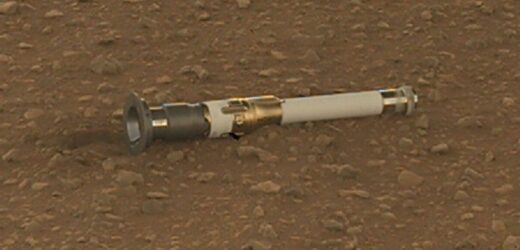NASA preparing for a long-term presence on the Moon
We use your sign-up to provide content in ways you’ve consented to and to improve our understanding of you. This may include adverts from us and 3rd parties based on our understanding. You can unsubscribe at any time. More info
New pictures released by NASA show an object on the surface of Mars, looking like a lightsaber from the iconic Star Wars series. Despite its appearance, this mysterious article is actually a titanium tube containing a rock sample resting on the Red Planet’s surface. Last Wednesday, the US space agency’s Perseverance Rover placed the tube there, ready for it to be taken back to Earth on a small spacecraft. NASA is now planning a future mission to retrieve the samples collected by the rover, bringing the first pieces of Mars back to Earth. This lightsaber-like sample tube is set to form a “depot of tubes” that would be considered for a journey back to Earth by the Mars Sample Return campaign.
The first tube to drop contained samples of a chalk-size core of igneous rock informally named “Malay,” which was collected on January 31, 2022, in a region of Mars’ Jezero Crater called “South Séítah.”
Over the next two months, Perseverance will deposit a total of ten tubes at this location, referred to as “Three Forks”, marking a historic step as humanity builds its first sample depot on another planet.
However, the rover has also been collecting duplicate samples from rock targets the mission selects. It currently has 17 other samples (including one atmospheric sample) taken so far in its belly.
In a blog post, NASA noted that “based on the architecture of the Mars Sample Return campaign, the rover would deliver samples to a future robotic lander”.


This lander would, in turn, use a robotic arm to place the samples in a containment capsule aboard a small rocket that would blast off to Mars orbit, where another spacecraft would capture the sample container and return it safely to Earth.
Should Perseverance fail to deliver its samples, the depot will serve as a backup supply for the Return campaign, at which time NASA will deploy a pair of Sample Recovery Helicopters to finish the job.
In the coming weeks, scientists have other opportunities to check Perseverance’s progress in making more sample deposits at the Three Forks cache.
Rick Welch, Perseverance’s deputy project manager at JPL, said: “Seeing our first sample on the ground is a great capstone to our prime mission period, which ends on January 6. It’s a nice alignment that, just as we’re starting our cache, we’re also closing this first chapter of the mission.”


A key objective for NASA Perseverance’s mission on Mars is astrobiology, which includes the search for signs of ancient microbial life, particularly by investing that the areas where Mars was flowing with rivers, millions of years ago.
NASA said: “The rover will characterize the planet’s geology and past climate, pave the way for human exploration of the Red Planet, and be the first mission to collect and cache Martian rock and regolith (broken rock and dust).
“Subsequent NASA missions, in cooperation with ESA (European Space Agency), would send spacecraft to Mars to collect these sealed samples from the surface and return them to Earth for in-depth analysis.
The Mars 2020 Perseverance mission is part of NASA’s Moon to Mars exploration approach, which includes Artemis missions to the Moon that will help prepare for human exploration of the Red Planet.
DON’T MISS:
China’s Covid horror laid bare as leaked note shows 250 million cases [REVEAL]
Macron faces ‘catastrophic’ nuclear energy crisis, expert claims [INSIGHT]
UK set to make nuclear fusion breakthrough and get ‘limitless’ energy [SPOTLIGHT]

Perseverance’s complex Sampling and Caching System took almost an hour to retrieve the lightsaber-like metal tube from inside the rover’s belly, view it one last time with its internal CacheCam, and drop the sample roughly 3 feet (89 centimeters) onto a carefully selected patch of Martian surface.
However, after dropping the tube, NASA engineers had to position the WATSON camera located at the end of Perseverance’s 7-foot-long (2-meter-long) robotic arm to peer beneath the rover, checking to be sure that the tube hadn’t rolled into the path of the rover’s wheels.
Meenakshi Wadhwa, the Mars Sample Return program principal scientist from Arizona State University said: “The samples for this depot – and the duplicates held aboard Perseverance – are an incredible set representative of the area explored during the prime mission.
“We not only have igneous and sedimentary rocks that record at least two and possibly four or even more distinct styles of aqueous alteration, but also regolith, atmosphere, and a witness tube.”
Source: Read Full Article


